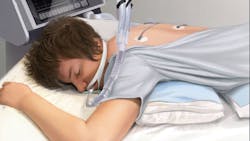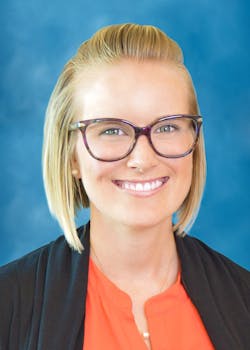Nursing Leaders Discuss New Prone-Positioning Recommendations in Hospitals
As a resource article entitled “Preventing Pressure Ulcers in Hospitals” and posted to the website of the Agency for Healthcare Research and Quality (AHRQ) notes, “Each year, more than 2.5 million people in the United States develop pressure ulcers. These skin lesions bring pain, associated risk for serious infection, and increased health care utilization. Moreover, the Centers for Medicare & Medicaid (CMS) no longer provides additional reimbursement to hospitals to care for a patient who has acquired a pressure ulcer while under the hospital's care. Thus, pressure ulcer prevention presents an important challenge in acute care hospitals. A number of best practices have been shown to be effective in reducing the occurrence of pressure ulcers, but these practices are not used systematically in all hospitals.”
What’s more, that article—first posted in 2012 and reviewed in 2023—notes that “Pressure ulcer prevention requires an interdisciplinary approach to care. Some parts of pressure ulcer prevention care are highly routinized, but care must also be tailored to the specific risk profile of each patient. No individual clinician working alone, regardless of how talented, can prevent all pressure ulcers from developing. Rather, pressure ulcer prevention requires activities among many individuals, including the multiple disciplines and multiple teams involved in developing and implementing the care plan. To accomplish this coordination, high-quality prevention requires an organizational culture and operational practices that promote teamwork and communication, as well as individual expertise. Therefore, improvement in pressure ulcer prevention calls for a system focus to make needed changes.”
Per that, the Aliso Viejo, Calif.-based American Association of Critical Care Nurses (AACN) on May 16, 2023, issued a new practice alert focused on prone position. The practice alert was posted to the association’s website. It begins, “During the COVID-19 pandemic, prone positioning became a customary treatment for patients with severe SARS-CoV-2 infections. Consequently, prone positioning was rapidly adopted by caregivers. Safely and effectively positioning the patient prone reduces risks of morbidity and mortality for the patient while reducing the risk of injury for the nurse and other caregivers. This Practice Alert addresses reducing the risk of harm to intubated adult ARDS patients undergoing manual prone positioning for at least 12 to 16 hours per day. Continuous prone positioning has been found to increase the risk of complications.”
“Many nurses proned their first patient during the pandemic, and as patients remain prone for longer stretches, the risk of complications grows. AACN developed this practice alert to provide a single place for clinicians to find best practices supported by published evidence,” said Devin Bowers, MSN, RN, NE-BC, AACN’s director of practice excellence. “Standardizing the practices related to prone positioning helps minimize associated patient risks while maximizing care team safety.”
And the practice alert noted the following things:
“The practice alert focuses on evidence-based strategies to prevent the most common proning-related complications for patients with ARDS who are undergoing prone positioning for more than 12 hours per day:
- Pressure injuries
- Airway obstruction and unplanned extubation
- Ocular and nerve injury
- Enteral nutrition issues”
The alert also discusses the importance of caregiver safety in minimizing risks of injury that can occur while turning a patient.”
The practice alert’s authors were Lauren Morata, DNP, APRN-CNS, CCNS, CPHQ, director of quality and performance improvement in the Clinical Quality area at Lakeland Regional Health in Lakeland, Florida; Kathleen Vollman, M.S.N., R.N., CCNS, a clinical nurse specialist and consultant based in Northville, Mich.; Jennifer Rechter, M.S.N., R.N.-BC, AGCNS-BC, a clinical nurse specialist and sepsis coordinator at Parkview Health in Fort Wayne, Ind; and Jill Cox, Ph.D. R.N., APN-C, CWOCN, of Rutgers University and Englewood Health, both in New Jersey. The four clinicians also presented an overview of the practice alert as part of the AACN Critical Care Webinar Series.
To what extent will it be necessary in any hospital organization for multidisciplinary governance and protocol development to be put into place in order to create consistent implementation of clinical protocols in this area? “Specific to prone, it is absolutely necessary,” says Lakeland Regional Health’s Morata. “Evidence has found a reduction in pressure injuries with implementation of these protocols; however, they need to be tailored to your patient population and the quality data specific to your institution. In addition, the latest evidence and guidelines should be incorporated into the protocols. Clinical protocols promote standard work and aid in accountability.”
To what extent is it possible to identify in advance the patients most at risk for pressure injuries resulting from prone positioning? Meaning, can advanced data analytics help support proactive intervention in this area? “It is clinically recognized that patients who require prone positioning have an increased severity of illness predisposing them to an increased risk for developing a pressure injury,” says Jill Cox, Ph.D., R.N., APN-c, CWOCN, FAAN clinical professor at Rutgers University School of Nursing (Newark, N.J.), and a wound/ostomy/continence advanced practice nurse at Englewood Health in Englewood, N.J. “Data analytics could be used to identify patients at risk based on level of acuity, comorbidities, baseline mobility, oxygen needs, BMI, and skin risk assessments. However, advanced data analytics (e.g. AI, machine learning) are currently in their infancy in pressure injury risk prediction,” Cox adds.
How about online tools? Can videos, for example, address the educational needs of bedside caregivers? “Not necessarily videos,” Cox says, “but there are online resources through National Pressure Injury Advisory Panel (NPIAP) and American Association of Critical Care Nurses that are available to bedside caregivers.”
Considering protocols before and after the COVID-19 pandemic
It is interesting to note that single-use, prophylactic multilayer polyurethane foam dressings were an established part of the nursing care plan that was already in place for patients at risk of impaired tissue integrity, prior to the COVID-19 pandemic. With regard to that, Kelly McFee, DNP, FNP-C, CWS, CWCN-AP, NE-BC, FACCWS, MAPWCA, a wound care nurse practitioner and the director of wound care at Mosaic Life Care Wound Care and Hyperbaric Medicine in St. Joseph, Mo., says that “The pressure injury prevention protocol that we had put in place prior to the pandemic did include the prophylactic dressings for use over bony prominences. However,” she notes, “what we generally encounter with the typical hospitalized patient was use of prophylactic dressings on posterior pressure points, such as the sacral area and heels. At the onset of the pandemic, as we started to understand the treatment protocols for COVID-19, we realized that we would be encountering risk for pressure injury in a manner that we hadn’t routinely noticed before, so we expanded our pressure injury prevention interventions for COVID patients in our critical care areas undergoing proning to include anterior pressure points, such as the collar bones, anterior hips, etc.”
In that regard, McFee notes that “Pressure injury prevention also included the face at this point – forehead, bridge of the nose, and cheeks and included consideration for dressing use under respiratory equipment. This really highlighted our awareness of pressure injury prevention with medical devices on a broader scale.”
To what extent will it be possible to identify in advance the patients most at risk for pressure injuries resulting from prone positioning? And can advanced data analytics help support proactive intervention in this area? “I’m certain that advanced data analytics could support proactive interventions, but I am not aware of what those would have been during the pandemic,” McFee says. “We focused on the tools that we had and continue to use, which are the Braden Skin Risk Tool to assess risk for skin breakdown, good nursing assessment, critical thinking, and applying pressure injury interventions based on those tools and assessments. The patients that we focused on were in the intensive care setting, so our most acute patients, and certainly our highest risk. These patients not only had complications resulting from COVID-19, but were sick enough to require the intensive care unit, were likely intubated, being proned, and required a high level of care.”
In that regard, McFee stresses, “It is imperative that pressure injury prevention be a multidisciplinary approach. There are too many moving parts and stakeholders involved for this to simply be a nursing or wound care endeavor.”
Education, nursing-materials management communication: crucial areas of activity
A number of questions around both educational issues and issues involving nursing-materials management communication, arise in this area. For example, leaders will have to determine what forms of education might be developed to support bedside caregivers, and whether in-person classroom-type training might be necessary, or whether online training can be effective. “I would anticipate that multiple forms of education will be ideal for pressure injury and medical device-related pressure injury prevention,” McFee says. “We have used both in-person and online training and continue to provide both. I think it is important to offer a variety to meet the various ways that caregivers learn.”
As for nursing leaders communicating with materials management leaders, McFee says that “When we started on our pressure injury prevention journey and began evaluating prophylactic dressings, we worked with and communicated with our supply chain partners and our Value Analysis Team (VAT) throughout that process. Our VAT process includes communication about anticipated usage of new materials for planning purposes. Most manufacturers can supply leaders with a VAT pack, which includes cost projections and cost savings projections for product use.”
Indeed, there are numerous implications here for nursing-materials management communication, Morata emphasizes. “As clinicians,” she says, “we rely heavily on our purchasing/materials management teams to support implementation of new clinical protocols. We need to work together to ensure the appropriate supplies are obtained, par levels are maintained, and the product is consistently available. The purchasing/materials management team can involve the clinical team to assist with identifying appropriate alternatives should material surges occur, staying ahead of the increased demand and a potential crisis. When usage increases unexpectedly, the purchasing/materials team should provide this feedback to clinical leaders. Through collaboration the two groups can identify the root cause for the increase, then determine the need for additional in-servicing or the potential need for an alternative product.”
Into the future—with NPIAP updates
How might the landscape around this change in the future? And how will the National Pressure Injury Advisory Panel (NPIAP) communicate with clinician leaders U.S. healthcare system-wide about additional learnings that should be shared with clinician leaders system-wide?
“The National Pressure Injury Advisory Panel is good to share up-to-date information related to pressure injury prevention, medical device-related pressure injury prevention, and even information related to prevention during the COVID-19 pandemic,” McFee emphasizes. “They share this information on their website and via their national conferences. As a wound care clinician and Director of Wound Care, I made it my responsibility to stay abreast of NPIAP updates and incorporate best practices into our standards of care. I think it is important that inpatient skin and wound programs continue to lead that charge for communicating updates to organizational leaders and implementing best practices moving forward.”
Cox agrees, adding that “NPIAP has a website that updates if practice changes occur around pressure injury prevention or treatment. Other professional organizations, such as the Wound, Ostomy, Continence Nurses Society have regional and national conferences to communicate practice standards regarding pressure injury prevention and treatment. In addition,” she notes, “clinical practice guidelines are updated every 5 years with the NPIAP and are disseminated globally and highlight the latest evidence-based practice surrounding pressure injury prevention and treatment. The next guideline will be published in 2025.”
About the Author
Mark Hagland
Mark Hagland is Editor-in-Chief of HPN's sister publication, Healthcare Innovation.



